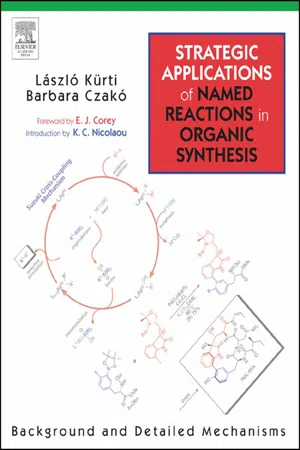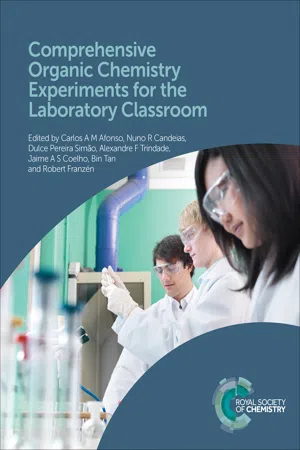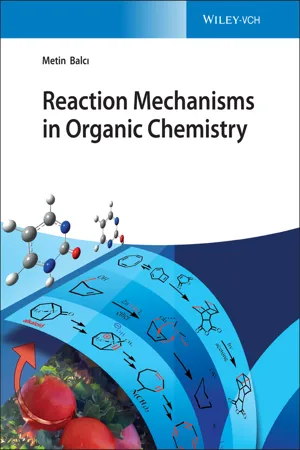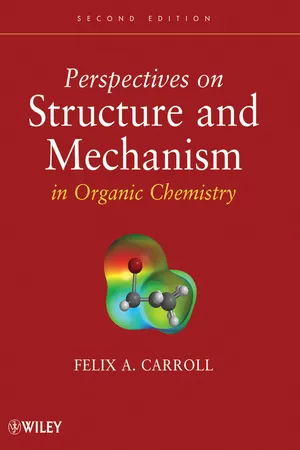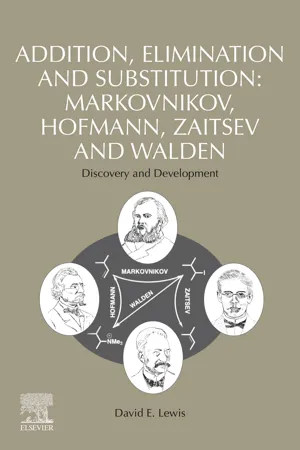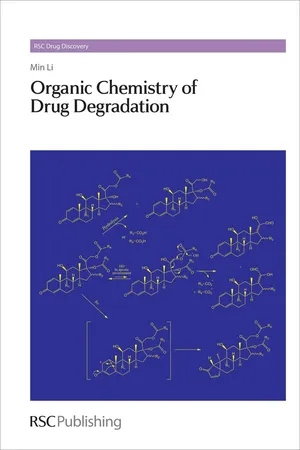Chemistry
Hoffman Elimination
Hofmann elimination is a chemical reaction that involves the removal of an amine group from a molecule. It is a type of elimination reaction that is used to convert primary amides to primary amines. The reaction is named after August Wilhelm von Hofmann, a German chemist who first described it in 1881.
Written by Perlego with AI-assistance
Related key terms
6 Key excerpts on "Hoffman Elimination"
- Laszlo Kurti, Barbara Czako(Authors)
- 2005(Publication Date)
- Academic Press(Publisher)
Under reduced pressure, the elimination tends to take place at lower temperatures with higher yields. When the substrate is heterocyclic or the nitrogen is at a ring junction or at the bridgehead, the above steps need to be repeated multiple times to completely eliminate the nitrogen from the molecule. In the old days the number of repetitions indicated the position of the nitrogen atom in the original molecule and gave valuable structural clues about the unknown substance. The Hofmann elimination is a β-elimination, that is, the hydrogen is abstracted by the base (hydroxide ion) from the β-carbon atom. In the case of unsymmetrical compounds (in which more than one alkyl group attached to the nitrogen has β-hydrogen atoms), the β-hydrogen located at the least substituted carbon is abstracted by the base to form the less substituted alkene (Hofmann’s rule). 1 The Hofmann elimination has few side reactions: occasionally the base can act as a nucleophile and substitution products are isolated. When the substrate does not have any alkyl groups with β-hydrogen, the main product of the pyrolysis is the substitution product (alcohol when water is the solvent or ether when no solvent is used). 13 An important variant of the Hofmann elimination is the Wittig modification in which the quaternary ammonium halide is treated with strong bases (alkylithiums, KNH 2 /liquid NH 3, etc.) to afford an olefin and tertiary amine via an E i mechanism. 11 Mechanism: 14–27, 11, 28–30, 12, 31–34 Generally the mechanism of the Hofmann elimination is E2, and it is an anti elimination (the leaving groups have to be trans -diaxial/antiperiplanar). However, in the case of certain substrates, the mechanism can be shifted in the carbanionic E1 cb direction when the trans elimination process is unfavorable and the compounds contain sufficiently acidic allylic or benzylic β-hydrogen atoms. In acyclic substrates, the elimination gives rise to the least substituted alkene (Hofmann product)- Carlos A M Afonso, Nuno R Candeias, Dulce Pereira Simão, Alexandre F Trindade, Jaime A S Coelho, Bin Tan, Robert Franzén(Authors)
- 2020(Publication Date)
- Royal Society of Chemistry(Publisher)
Keywords Carbocations, dehydration, distillation, GC-MS, IR, NMRBackground
Eliminations are one of the most important types of reactions within organic chemistry. In these reactions, a single molecule splits into two molecules. Typically, one of these molecules is a small (diatomic or triatomic) compound, while in the other fragment a π-bond is formed. The general form is shown in Scheme 9.1.3.1 , in which X represents a leaving group. A hydrogen atom from the carbon atom adjacent to the leaving group is abstracted.Scheme 9.1.3.1 General elimination reaction.Elimination reactions often lead to the formation of multiple compounds, as hydrogen atoms can be abstracted from chemically different carbons atoms. The product composition is determined by the stability of the resulting alkenes, the mechanism involved and the conformational dependence of the elimination process. For instance, dehydrohalogenation of menthyl chloride under E2 conditions gives 100% 2-menthene, while under E1 conditions 32% 2-menthene and 68% 3-menthene are obtained (Scheme 9.1.3.2 ).1Scheme 9.1.3.2 Possible dehydrohalogenation pathways of menthyl chloride.In this experiment, you will perform an acid-catalysed dehydration of a methylcyclohexanol. The dehydration agent is concentrated (85%) phosphoric acid. You will do the reaction with one of three possible starting compounds: 2-methylcyclohexanol, 3-methylcyclohexanol, or 4-methylcyclohexanol. Other members of your group will start with another methylcyclohexanol. Note that mixtures of the cis - and trans -isomers of the methylcyclohexanols will be used. You will determine the product distribution by the use of GC-MS and 1 H NMR spectroscopy, while infrared spectroscopy also will be used. By comparing the results obtained for different starting alcohols, together you will gain surprising insights into the mechanism of the dehydration reactions.Before You Start
In your organic chemistry textbook, study the theory of elimination reactions in general, and dehydration of alcohols in particular. Read about E1 and E2 mechanisms, the stability of carbocations, rearrangements and Zaitsev’s rule.- eBook - ePub
- Metin Balc?, Metin Balc?, Metin Balc?, Metin Balc?, Metin Balc?(Authors)
- 2021(Publication Date)
- Wiley-VCH(Publisher)
When the Hofmann elimination is applied to 3-methylprolidine, 2-methylbutadiene is obtained. When we compare the two reactions, it is seen that the alkenes formed are different. The structure of the alkenes depends on the location of the methyl group in the pyrrolidine ring. Thus, moving back from the reaction results, it is possible to find out where the methyl group was in the ring before the Hofmann elimination. This is an important clue in the structure analysis of alkaloids with a complex structure.It is well established that the leaving groups in the Hofmann elimination must be in the anti-periplanar conformation. Otherwise, elimination cannot take place. For example, in trans-4-t-butylcyclohexyltrimethylammonium hydroxide, substituents prefer the equatorial–equatorial conformation [35 , 36] . In this conformation, the molecule cannot have the required anti-periplanar conformation. In an anti-periplanar conformation, both groups (t-butyl and trimethylamine) will be in axial positions, which will increase the energy of the molecule. Therefore, the trans-isomer does not produce an elimination product. The situation is different in the cis-isomer. An essential part of the molecule will be in the conformation shown below. Because the hydrogen and an amine group to be eliminated are in the anti-periplanar conformation, elimination takes place to form a cyclohexene ring in 92% yield.The Hofmann degradation has been successfully applied to the synthesis of some compounds. Cyclooctatetrane was first synthesized by Richard Willstaetter in 1905. He recognized its potential as a starting material for the synthesis of a carbocyclic eight-membered ring. The synthesis consists of progressive degradation of an alkaloid named pseudopelletierine obtained from the root bark of the pomegranate tree [37 –39] . The synthetic steps are given below.Hofmann eliminations are not limited to tetraalkylammonium salts. Elimination reactions take place with phosphonium and sulfonium salts of a similar structure. Base-promoted elimination of dimethyl-sec-butyl sulfonium salt gives 1-butene as the major product in 74% yield and 2-butenes (cis- and trans-mixture) in 26% yield. Electron withdrawal increases here the acidity of β-hydrogen atoms. The proton Ha from the methyl groups is more acidic than the proton Hb from the methylene group. Therefore, the base abstracts one of the acidic protons, Ha - No longer available |Learn more
- Felix A. Carroll(Author)
- 2011(Publication Date)
- Wiley(Publisher)
76FIGURE 10.29Reaction coordinate diagram for E1 elimination of HBr from 2-bro-mo-2-methyl butane.TABLE 10.3Product Distributions in Hofmann Eliminations of R1 R2 (CH3 )2 N+ HO–source : Reference 75(10.37)Hughes, Ingold, and co-workers generalized Hofmann’s observation to mean that elimination of an alkene from a quaternary ammonium ion bearing only alkyl groups will produce as the major product that alkene with the fewer alkyl substituents on the carbon–carbon double bond.3, 77 This generalization was not limited to the Hofmann elimination itself, but it was also applied to any bimolecular elimination in which the leaving group bears a positive charge when bonded to the substrate (and thus leaves as a neutral species). As an example, Ingold and co-workers noted that ethoxide-promot-ed elimination of dimethyl-sec -butylsulfonium ion (15) produced 26% of the 2-butenes (predominantly trans) and 74% of 1-butene (equation 10.38 ).78 Other molecules that give similar selectivity include tetraalkylphosphonium salts, so Hofmann orientation is said to be a characteristic of the “–onium’’ (sulfonium, ammonium, etc.) compounds.(10.38)The anti-coplanar reaction pathways that lead to Saytzeff or Hofmann orientation are shown in Figure 10.30 . Why should a reactant with one leaving group react preferentially by one pathway, while a species with a different leaving group reacts primarily by a different pathway? If the elimination reaction is not reversible under the experimental conditions, then a higher yield of Hofmann product than Saytzeff product suggests that the transition state leading to the Saytzeff product must be higher in energy than that leading to Hofmann product. The more substituted alkene is more stable than the less substituted alkene, no matter the pathways by which these products are formed. Therefore, the transition state energies in a reaction producing Hofmann orientation cannot reflect product stabilities. That conclusion suggests a reaction coordinate diagram such as that shown in Figure 10.31 - eBook - ePub
Addition, Elimination and Substitution: Markovnikov, Hofmann, Zaitsev and Walden
Discovery and Development
- David E. Lewis(Author)
- 2022(Publication Date)
- Elsevier(Publisher)
91Scheme 5.11 Variations of the Hofmann rearrangement reported by Hofmann.Scheme 5.12 Variations of the Hofmann rearrangement reported by Hofmann.Scheme 5.13 Recent examples of Hofmann rearrangements that mitigate problems with the reaction.The Hofmann elimination
92When Hofmann described the synthesis of quaternary ammonium halides, he also reported their reaction with moist silver oxide to give the quaternary ammonium hydroxides that were, in contrast to the tertiary amines from which they were formed, very strong bases. He reported that when an ethyl group was present and could be eliminated as ethylene, this was the only reaction observed (Scheme 5.14 ).Hofmann's original work was followed fairly quickly by a report by British chemist J. Norman Collie (1859–42) and his student, S. B. Schryver, in which the effects of the quaternary ammonium ion structure on the outcome of the elimination were studied.93Their findings, which are summarized in Table 5.1 , confirmed Hofmann's own conclusions about ethylammonium salts with a range of different quaternary salts, although they did also observe that benzyltrimethylammonium ion gave benzyl alcohol.Beginning in 1911, German chemist Julius von Braun undertook a two-decade program of research into the pyrolysis of quaternary ammonium hydroxides that was one of the most extensive of the era.94 –100Von Braun especially focused on the “anomalous” elimination reaction of alkyltrimethylammonium hydroxides, which gave methanol by the competing SN 2 displacement at the trimethylammonium group. Von Braun found that as the length of the alkyl chain increases, the relative amount of the substitution product rises from 0% to 75%. Von Braun's results are summarized in Table 5.2 - eBook - ePub
- Min Li(Author)
- 2015(Publication Date)
- Royal Society of Chemistry(Publisher)
CHAPTER 4 Various Types and Mechanisms of Degradation Reactions4.1 Elimination
An elimination reaction is one in which two substituents are removed or eliminated from the parent molecule. The elimination can proceed either via a one- or two-step mechanism, known as E1 and E2 elimination, respectively (Scheme 4.1 ). The numbers 1 and 2 here refer to the orders, rather than the steps, of the elimination reactions. In the E1 elimination, an intermediate is formed by the elimination of the first substituent, which is then followed by the elimination of the second substituent. The first step of the E1 elimination is usually the rate-liming step and hence the reaction is of first order relative to the elimination substrate. In the E2 elimination, a concerted mechanism is operative; frequently, a base is required to effect the concerted elimination of the two substituents. Therefore, the reaction is second order owing to the involvement of the two reactants.Scheme 4.1In both types of the elimination reaction, the double bond equivalency (DBE) of the resulting degradation product increases by one, that is, the elimination causes the formation of a double bond (from a single bond), a triple bond (from a double bond), or a ring. The most pharmaceutically relevant drug degradation via elimination is probably dehydration. Other elimination reactions that have been observed in pharmaceutical products include dehydrohalogenation (elimination of HX, where X=halogen such as Cl) and the Hofmann elimination. Decarboxylation is a degradation reaction that is closely related to, but is not elimination. They will be discussed in the following sub-sections, respectively.4.1.1 Dehydration
Dehydration is probably the most commonly seen degradation type due to an elimination reaction. Several corticosteroids containing the 1,3-dihydroxyacetone side chain on the D-ring, such as dexamethasone, betamethasone, prednisolone, and cortisol undergo a dehydration reaction known as the Mattox rearrangement (which is actually not a rearrangement), in particular under acidic conditions.1 ,2During the Mattox process as shown in Scheme 4.2
Index pages curate the most relevant extracts from our library of academic textbooks. They’ve been created using an in-house natural language model (NLM), each adding context and meaning to key research topics.
